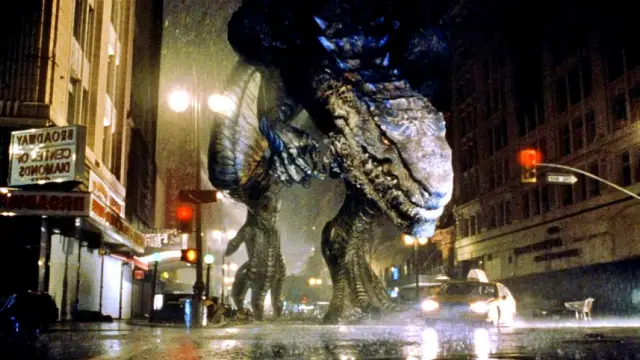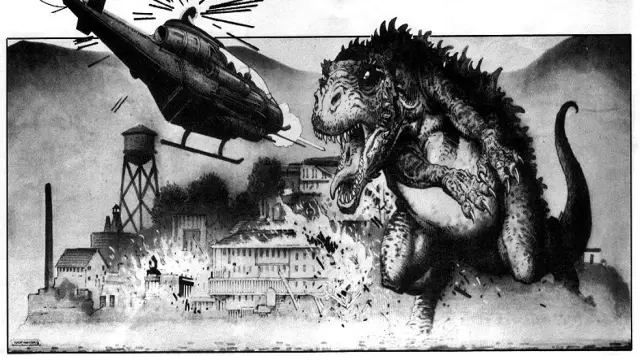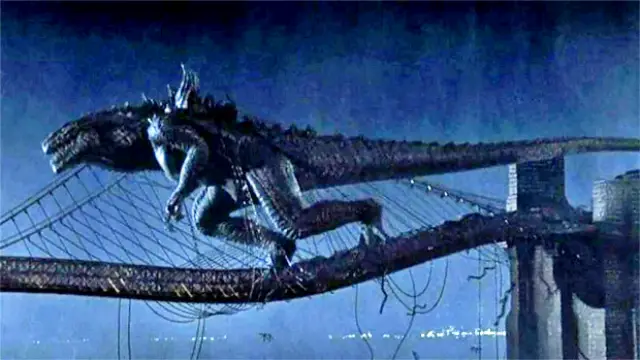When Hollywood decided to take on the iconic Godzilla franchise in 1998, fans of the legendary monster were both excited and skeptical. Directed by Roland Emmerich, the mastermind behind blockbuster hits like Independence Day, the film promised a fresh take on the King of All Monsters. However, what audiences got was a far cry from the Godzilla they knew and loved. Despite its box office success, the film was widely criticized, leaving fans disappointed and sparking debates about Hollywood’s ability to handle beloved franchises.
The Hype and the Letdown
The anticipation for Godzilla (1998) was immense. Sony Pictures kept the monster’s design under tight wraps, fueling curiosity. Leaked concept art only added to the mystery, but no one knew for sure what the new Godzilla would look like. When the film finally hit theaters, the reveal left many fans underwhelmed. This wasn’t the Godzilla they remembered from the classic Japanese films. Instead, it was a sleek, dinosaur-like creature that lacked the charm and grandeur of the original.

Box Office Success vs. Fan Backlash
Despite the backlash, Godzilla (1998) was a commercial success, grossing $379 million worldwide. American audiences flocked to theaters, drawn by the spectacle and Emmerich’s reputation for delivering big-budget entertainment. However, the film’s financial success couldn’t mask its flaws. Longtime Godzilla fans felt betrayed by the creature’s redesign and the film’s departure from the franchise’s core elements.
What Went Wrong?
Roland Emmerich and his team aimed to modernize Godzilla, stripping away the “cheesiness” of the Japanese films. But in doing so, they removed what made Godzilla unique. The 1998 version lacked the atomic breath, glowing dorsal fins, and epic battles with other monsters that defined the original series. Instead, this Godzilla was portrayed as a giant animal searching for food and a place to lay its eggs—a far cry from the god-like force of nature fans adored.
Emmerich’s decision to distance the film from its roots alienated the core fanbase. As one critic put it, “This isn’t Godzilla; it’s just a big lizard.” The film’s failure to capture the spirit of the franchise led to its harsh reception, particularly in Japan, where audiences dismissed it as “Godzilla in name only.”
The Legacy of the 1998 Godzilla
Interestingly, the 1998 film has become a fascinating footnote in Godzilla history. In Godzilla: Final Wars (2004), Toho Studios addressed the American version by pitting the classic Godzilla against the 1998 creature, dubbed “Zilla.” The battle was short and one-sided, with the Japanese Godzilla effortlessly defeating Zilla. A character in the film even quips, “Good for nothing tuna-eating monster,” summing up Toho’s disdain for Emmerich’s interpretation.

Hollywood’s Earlier Attempts
The 1998 film wasn’t Hollywood’s first attempt to bring Godzilla to American audiences. Two earlier projects, Godzilla: King of the Monsters 3-D (1983-1984) and Godzilla ’94 (also known as Godzilla vs. The Gryphon), were in development but never made it to production. Both projects had impressive creative teams and ambitious plans, but studio concerns over budgets and marketability led to their cancellation.
- Godzilla: King of the Monsters 3-D: Directed by Steve Miner and written by Fred Dekker, this film aimed to resurrect Godzilla through a nuclear accident. Conceptual artwork by William Stout and contributions from special effects legend Rick Baker made it a promising project. However, the proposed $30 million budget was deemed too high for a “children’s film,” and the project was shelved.
- Godzilla ’94: Directed by Jan De Bont and written by Terry Rossio and Ted Elliott, this film would have featured Godzilla battling a new monster called The Gryphon. With designs by Stan Winston Studios, the project promised cutting-edge effects and a faithful homage to the Japanese films. However, budget disputes led to its cancellation, paving the way for Emmerich’s version.
Lessons Learned
The 1998 Godzilla and its shelved predecessors highlight the challenges of adapting beloved franchises. Hollywood’s focus on marketability often clashes with the need to honor a franchise’s legacy. While Emmerich’s film succeeded financially, it failed to resonate with fans, proving that box office numbers aren’t everything.
The Future of Godzilla in Hollywood
Since 1998, Hollywood has made another attempt at the franchise with Godzilla (2014), directed by Gareth Edwards. This film, produced by Legendary Pictures, sought to restore Godzilla’s iconic status, blending modern effects with the monster’s classic traits. The result was a more faithful adaptation that pleased both critics and fans, paving the way for sequels and the MonsterVerse franchise.
Conclusion
Roland Emmerich’s Godzilla (1998) remains a cautionary tale about the risks of reinventing a beloved icon. While it had its moments as a monster movie, it failed to capture the essence of Godzilla, leaving fans longing for the creature’s classic roots. As Hollywood continues to explore the Godzilla franchise, the lessons from 1998 serve as a reminder: sometimes, staying true to the source material is the key to success.
What do you think about the 1998 Godzilla? Do you believe it deserves a second chance, or was it a misstep best left in the past? Let us know in the comments below!

